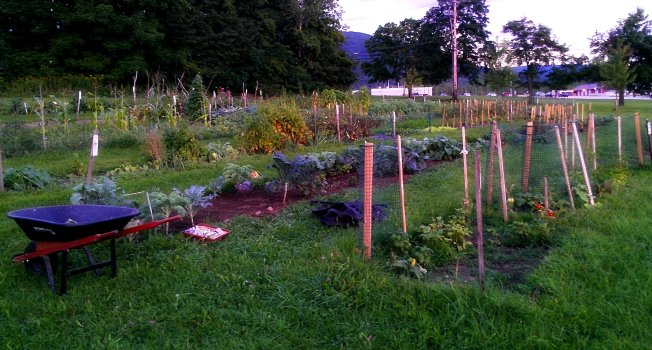By Elizabeth Theriault
The United States has a long history of community gardens. During World War I and II they were known as victory or war gardens. The government encouraged citizens to start growing their own food in order to support the war effort and reduce the pressure on public food supply. Victory gardeners contributed labor and were rewarded with fresh produce during a time when it was scarce.
In recent years, there is a resurgence of this style of community garden. People are raising their garden forks not for war on foreign soil, but a fight for equal access to fresh healthy food. In a time where people are talking about food deserts (an area that has little or no access to groceries with fresh produce), soaring food prices, fuel scarcity and climate change, community gardens can serve as a source of food and sovereignty.
During World War II farmers had been recruited into military service resulting in a shortage of farmers to grow the nation’s food supply. Today we are faced with a new type of challenge. The USDA reported that the U.S. has lost 800,000 farmers and ranchers in the last 40 years. Between 1900 and 2002, the number of farms in the U.S. shrank by 63 percent, while the average farm size increased by 67 percent. The dairy industry has suffered even larger losses over the past 35 years, between 1970 and 2006; the country lost 88 percent of its dairy farms, while the average herd size per farm increased from 19 to 120 cows. These statistics reveal an increased reliance upon a shrinking number of larger, heavily mechanized farms. In areas with industrialized agriculture there are signs that our food supply is vulnerable. With water shortages in the western United States, rising cost of fuel, and soil degradation leading to ever increasing amounts of chemical “inputs” to create fertility – one has to wonder what the future will look like for food production. Who is going to grow our food in the future?
Fortunately, there is a counter-trend. The summer after I graduated from college I moved back home to a small town in coastal Maine to find a job. I worked for an organization called Youthlinks that provided “at risk” youth programs to teach them life skills and engage them in the community. At Youthlinks I met a young farmer named Rachel who ran a small organic farm and spent one day a week building a community garden with the youth. Rachel taught kids how to grow organic food and flowers but she also taught them about a way of life. Rachel taught students how to be stewards of the land by nurturing the soils and plants and never using chemical fertilizers or herbicides. This little community garden plot became a place for kids to grab a healthy fresh snack right off the vine at the end of the day, connect with their environment, learn practical life skills and create a sense of community. Community gardens have the potential to transform communities through increased access to healthy fresh food, a connection with the environment, satisfying labor, neighborhood improvement and a sense of community.
This concept is not lost on Rutland City officials and community members who have been revitalizing Rutland city neighborhoods. In the last two weeks a new community garden has been built in Rutland’s Northwest community on Baxter Street. The garden was built by volunteers including Rutland city’s Mayor Chris Louras and many people of all ages from the neighborhood. The garden will be overseen by the Recreation and Parks Department, the Mayor’s office and Sustainable Rutland.
I spoke with Carol Tashie of Radical Roots Farm in West Rutland, a founding member of Sustainable Rutland and member of RAFFL’s board of directors, about the bigger picture for Rutland and community gardens. Carol explained that the long term goal for Rutland is to have a community garden in every neighborhood so everyone can walk from their house to a garden. Carol stated,” The community garden is designed to build community. It is wonderful to have food and flowers grown on the land. And, real beauty and magic comes from building community and caring for the land together.”
There are many types of community gardens all over this area from Castleton to Middletown Springs to Manchester. Some are designed to encourage community participation and others provide plots for rent to gardeners who need more space than they have at home. Rutland City has two gardens where plots are for rent: on Woodstock Avenue and on Allen Street.
RAFFL is starting a new project at the community garden on Allen Street in partnership with PEG TV and Rutland Recreation and Parks Department. Called Rutland Grows!, this community growing project is for Rutland city residents who want to learn how to grow their own food and learn how we can change our food system to create a sustainable future where everyone has access to fresh healthy food. In addition to hands-on learning, PEG TV will be airing a series of shows taped at the gardens. To get more information about Rutland Grows! contact Elizabeth at 417-1528 or Elizabeth@rutlandfarmandfood.org. And, remember, any excess food you grow this summer can be donated to area food shelves. You can also drop off your donation any Saturday at the end of the Downtown Rutland summer market where RAFFL volunteers gather food and then distribute it to food shelves across the county.
Elizabeth Theriault is Community Engagement Coordinator at the Rutland Area Farm and Food Link
